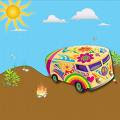
George Carlin was the very first host of a show, which has become a cultural phenomenon. The long-running sketch comedy has featured a great number of comedians, many who have gone on to be quite successful. The program has become a parody of cultural and political news, deliberately poking fun at news worthy events. A host always opens the show with a monologue, the SNL band and a musical guest every week. Since its inception, SNL has been in the same night – Saturday – and the same time slot – 11:30pm. On three separate occasions the show was forced by the network to run on a five-second delay; Richard Pryor, Sam Kinison, and Andrew Dice Clay were the host. Although it seems the line, “Live from New York, it’s Saturday night!” has always been a part of the show, this line did not begin until 1982.
The first cast of comedians included: Dan Aykroyd, John Belushi, Chevy Chase, George Coe, Jane Curtin, Garrett Morris, Laraine Newman, Michael O'Donoghue, and Gilda Radner. They became known as the “Not Ready For Prime Time Players.” SNL is well-known for finding new comedians, many of whom have gone on to become very successful, not only in comedy, but also acting. Chase left the show during the second season and was replaced by comedianBill Murray.Aykroyd and Belushi left the show after season four and went on to become the “Blues Brothers.” Other comedians made famous by the show include: Eddie Murphy, Joe Piscopo, Billy Crystal, Martin Short, and Harry Shearer.

My favorite segment of the program has always been the news sketch “Weekend Update,” originally created and anchored by Chase. Many different people have hosted the “Weekend Update,” but my favorite was Dennis Miller from 1985-1991. His sign-off catch phrase was, “That’s the news, and I am outta here!” He would then scribble something on his script and toss it into the air. In May 1976, the students from Harrodsburg High School did an imitation of SNL on the stage at the Old Fort Harrod Amphitheatre for “senior night,” and my husband, Keith did an imitation of “Weekend Update.” He had a desk on stage, where he sat to read the news and he had a lit candle in one of the open drawers. One of his jokes was to set a page from the script on fire and say, “And now breaking news about that fire in Salvisa.”
With the exception of season six through ten, the show has been overseen by its creator and executive producer, Michaels, who is often seen at some point during the show. “Saturday Night Live” is one of the longest-running network television programs in the United States with over 700 episodes during the past 35 years. Many of the show's sketches have been developed into feature films. SNL has received many awards, including 21 Primetime Emmy Awards, a Peabody Award, and three Writers Guild of America Awards. During the recent 2010 Emmy season, SNL received 13 nominations, making history for having the television program with the most Emmy nominations (126) in television history.
To date, Alex Baldwin and Steve Martin have been the host of SNL 15 times each. Comedians, actors, musicians, sports figures, political leaders, even past cast members, have all been the host of SNL. The oldest host has been Betty White, age 88, this past May. The youngest host was Drew Barrymore, age 7 in 1982.




















































